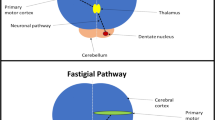Abstract
The aim of this study was to investigate physiological mechanisms underlying ataxia in patients with ataxic hemiparesis. Subjects were three patients with ataxic hemiparesis, whose responsible lesion was located at the posterior limb of internal capsule (case 1), thalamus (case 2), or pre- and post-central gyri (case 3). Paired-pulse transcranial magnetic stimulation (TMS) technique was used to evaluate connectivity between the cerebellum and contralateral motor cortex. The conditioning cerebellar stimulus was given over the cerebellum and the test stimulus over the primary motor cortex. We studied how the conditioning stimulus modulated motor evoked potentials (MEPs) to the cortical test stimulus. In non-ataxic limbs, the cerebellar stimulus normally suppressed cortical MEPs. In ataxic limbs, the cerebellar inhibition was not elicited in patients with a lesion at the posterior limb of internal capsule (case 1) or thalamus (case 2). In contrast, normal cerebellar inhibition was elicited in the ataxic limb in a patient with a lesion at sensori-motor cortex (case 3). Lesions at the internal capsule and thalamus involved the cerebello-thalamo-cortical pathways and reduced the cerebellar suppression effect. On the other hand, a lesion at the pre- and post-central gyri should affect cortico-pontine pathway but not involve the cerebello-thalamo-cortical pathways. This lack of cerebello-talamo-cortical pathway involvement may explain normal suppression in this patient. The cerebellar TMS method can differentiate cerebellar efferent ataxic hemiparesis from cerebellar afferent ataxic hemiparesis.


Similar content being viewed by others
References
Fisher CM, Cole M. Homolateral ataxia and crural paresis: a vascular syndrome. J Neurol Neurosurg Psychiatry. 1965;28:48–55.
Fisher CM. Ataxic hemiparesis. A pathologic study. Arch Neurol. 1978;35:126–8.
Gorman MJ, Dafer R, Levine SR. Ataxic hemiparesis. Critical appraisal of a lacunar syndrome. Stroke. 1998;29:2549–55.
Moulin T, Bogousslavsky J, Chopard JL, Ghika J, Crépin-Leblond T, Martin V, et al. Vascular ataxic hemiparesis: a re-evaluation. J Neurol Neurosurg Psychiatry. 1995;58:422–7.
Hiraga A, Uzawa A, Kamitsukasa I. Diffusion weighted imaging in ataxic hemiparesis. J Neurol Neurosurg Psychiatry. 2007;78:1260–2.
Kelly MA, Perlik SJ, Fisher MA. Somatosensory evoked potentials in lacunar syndrome of pure motor and ataxic hemiparesis. Stroke. 1987;18:1093–7.
Dupuis MJ, Evrard FL, Jacquerye PG, Picard GR, Lermen OG. Disappearance of essential tremor after stroke. Mov Disord. 2010;25:2884–7.
Mochizuki H, Ugawa Y. Disappearance of essential tremor after stroke: which fiber of cerebellar loops is involved in posterior limb of the internal capsule? Mov Disord. (2011. doi:10.1002/mds.23712.
Ugawa Y, Terao Y, Hanajima R, Sakai K, Furubayashi T, Machii K, et al. Magnetic stimulation over the cerebellum in patients with ataxia. Electroencephalogr Clin Neurophysiol. 1997;104:453–8.
Mochizuki H, Huang YZ, Rothwell JC. Interhemispheric interaction between human dorsal premotor and contralateral primary motor cortex. J Physiol. 2004;561:331–8.
Ugawa Y, Uesaka Y, Terao Y, Hanajima R, Kanazawa I. Magnetic stimulation over the cerebellum in humans. Ann Neurol. 1995;37:703–13.
Axer H, Keyserlingk DGv. Mapping of fiber orientation in human internal capsule by means of polarized light and confocal scanning laser microscopy. J Neurosci Methods. 2000;94:165–75.
Parent A. Carpenter's human neuroanatomy. 9th ed. Baltimore: Williams & Wilkins; 1996. p. 682–5.
Kamali A, Kramer LA, Frye RE, Butler IJ, Hasan KM. Diffusion tensor tractography of the human brain cortico-ponto-cerebellar pathways: a quantitative preliminary study. J Magn Reson Imaging. 2010;32:809–17.
Behrens TE, Johansen-Berg H, Woolrich MW, Smith SM, Wheeler-Kingshott CA, Boulby PA, et al. Non-invasive mapping of connections between human thalamus and cortex using diffusion imaging. Nat Neurosci. 2003;6:750–7.
Conflicts of interest
The authors declare that there are no potential conflicts.
Author information
Authors and Affiliations
Corresponding author
Rights and permissions
About this article
Cite this article
Kikuchi, S., Mochizuki, H., Moriya, A. et al. Ataxic Hemiparesis: Neurophysiological Analysis by Cerebellar Transcranial Magnetic Stimulation. Cerebellum 11, 259–263 (2012). https://doi.org/10.1007/s12311-011-0303-0
Published:
Issue Date:
DOI: https://doi.org/10.1007/s12311-011-0303-0




